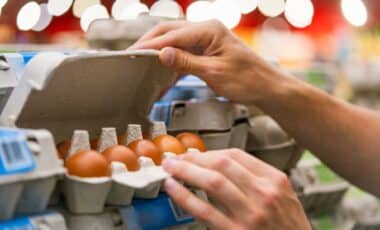Despite a sharp monthly decline in April, egg prices in the United States remain nearly double last year’s figures, due to the continued impact of avian flu and supply issues. The recent drop comes after months of sustained highs, driven by widespread outbreaks and increasing production costs.
Retail egg prices in the United States fell in April, ending a seven-month streak of rising costs that had pushed prices to record levels. Data from the U.S. Bureau of Labor Statistics shows a notable 12.7% drop in prices — the steepest monthly decline since March 1984.
This decrease brings temporary relief to consumers but does not signal a return to pre-crisis levels. Despite the April decline, egg prices remain significantly higher than a year ago. Experts point to continued supply constraints and the ongoing threat of bird flu as key factors keeping prices elevated.
Bird Flu and Its Lingering Impact on Supply Chains
Egg prices peaked in March 2025 at an average of $6.23 per dozen, before dropping to $5.12 in April, according to data from the Bureau of Labor Statistics. This marks the first month-to-month decline since October 2024. However, the current average is still 79% higher than in April 2024, when eggs sold for $2.86 per dozen.
The price surge has been driven largely by an outbreak of highly pathogenic avian influenza (HPAI). According to the U.S. Department of Agriculture, bird flu has led to the culling of over 169 million birds since early 2022.
Just in April, outbreaks at two large farms in Ohio and South Dakota resulted in the loss of over 927,000 egg-laying hens. When an outbreak is detected, entire flocks are culled to prevent the virus from spreading — a measure that disrupts supply for months, as farms require up to a year to recover.
David L. Ortega, professor of food economics and policy at Michigan State University, stated that demand typically falls after Easter, contributing to the price drop. However, he cautioned that prices could increase again if new outbreaks occur, highlighting the volatility of the situation.
Measures to Stabilise Supply and Market Conditions
In response to the crisis, the U.S. government has taken several steps aimed at securing the national egg supply. In February, the Department of Agriculture announced a $1 billion investment to help farmers improve biosecurity and contain the spread of the virus.
Imports have also played a role in easing pressure on domestic supply. According to Wells Fargo Agri-Food Institute, egg and egg product imports increased by 77.5% during the first quarter of 2025, compared to the same period in 2024. Countries such as South Korea, Turkey, and Brazil have been key suppliers during the crisis.
Meanwhile, the Department of Justice has launched an antitrust investigation into Cal-Maine Foods, the country’s largest egg producer. The Mississippi-based company, which supplies about 20% of the national market, recently reported a threefold increase in net income to $508.5 million in the quarter ending 1 March.









